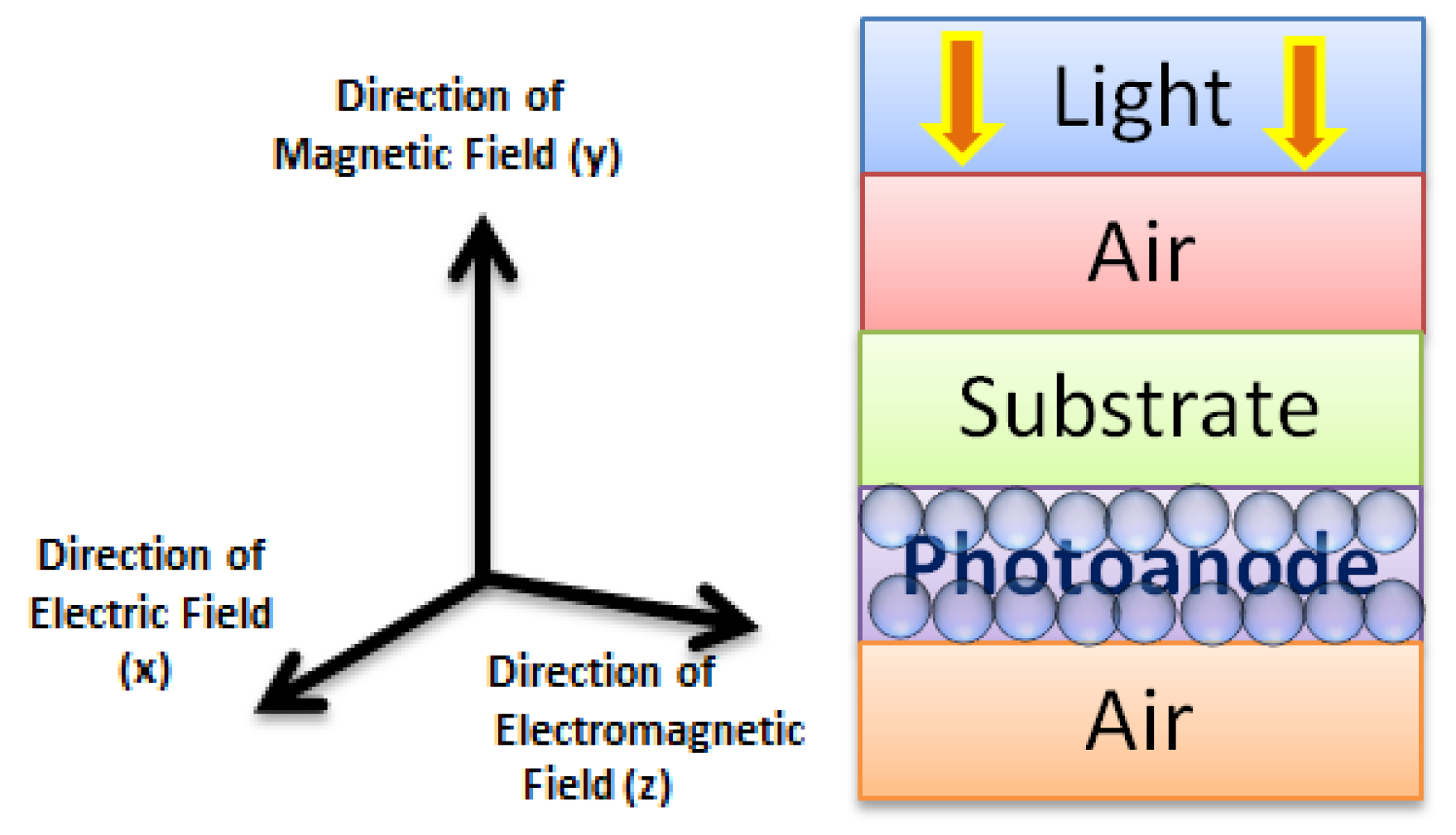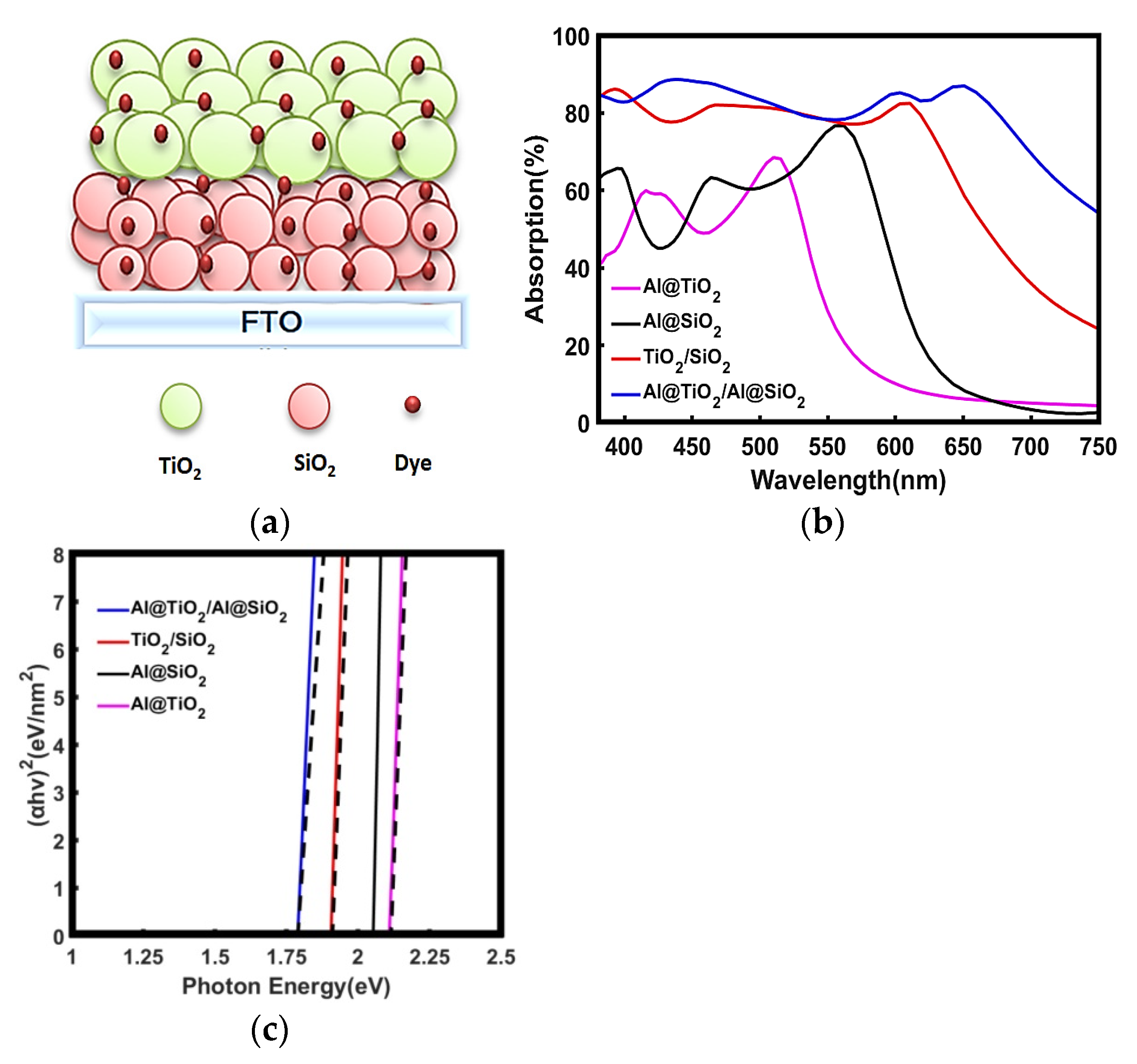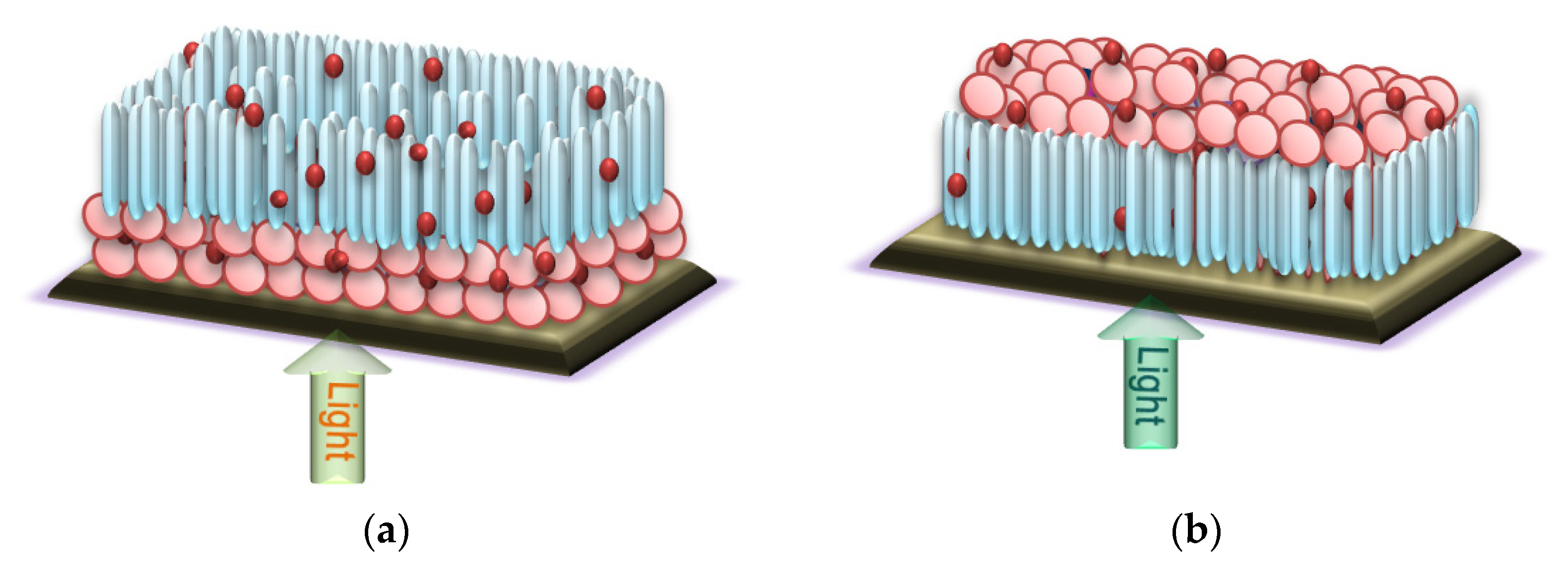Enhanced Absorption Performance of Dye-Sensitized Solar Cell with Composite Materials and Bilayer Structure of Nanorods and Nanospheres
Abstract
:1. Introduction
2. Simulation Model
3. Results and Discussion
3.1. Photoanodes Based on TiO2 and SiO2
3.2. Photoanodes Based on Various Geometries of Plasmonic Nanoparticles Incorporated in SiO2
3.3. Photoanodes Based on Spherical Al@SiO2, Al@TiO2 and Their Bilayer Composite Structures
3.4. Photoanode Based on a Nanosphere/Nanorod Mixture Bilayer Structure for Al@SiO2
4. Conclusions
Author Contributions
Funding
Institutional Review Board Statement
Informed Consent Statement
Conflicts of Interest
References
- Al-Qurashi, O.S.; Wazzan, N.A.; Obot, I.B. Exploring the effect of mono- and di-fluorinated triphenylamine-based molecules as electron donors for dye-sensitised solar cells. Mol. Simul. 2019, 46, 41–53. [Google Scholar] [CrossRef]
- Hilal, R.; Aziz, S.G.; Osman, O.I.; Bredas, J.-L. Time dependent—Density functional theory characterization of organic dyes for dye-sensitized solar cells. Mol. Simul. 2017, 43, 1523–1531. [Google Scholar] [CrossRef]
- Zhang, Q.; Sun, J.; Shang, K.-X.; Liu, J.-C.; Li, R.-Z.; Jin, N.-Z. A dye-sensitized solar cell containing an anchoring porphyrin. J. Co-Ord. Chem. 2017, 70, 780–789. [Google Scholar] [CrossRef]
- Huaulmé, Q.; Mwalukuku, V.M.; Joly, D.; Liotier, J.; Kervella, Y.; Maldivi, P.; Narbey, S.; Oswald, F.; Riquelme, A.J.; Anta, J.A.; et al. Photochromic dye-sensitized solar cells with light-driven adjustable optical transmission and power conversion efficiency. Nat. Energy 2020, 5, 468–477. [Google Scholar] [CrossRef]
- Oh, W.-C.; Chanthai, S.; Areerob, Y. Novel flexible Ag nanoparticles doped on graphene—Ba2GaInO6 as cathode material for enhancement in the power conversion of DSSCs. Sol. Energy 2019, 180, 510–518. [Google Scholar] [CrossRef]
- Mustafa, M.N.; Shafie, S.; Wahid, M.H.; Sulaiman, Y. Optimization of power conversion efficiency of polyvinyl-alcohol/titanium dioxide compact layer using response surface methodology/central composite design. Sol. Energy 2019, 183, 689–696. [Google Scholar] [CrossRef]
- Rehman, A.U.; Aslam, M.; Khan, M.; Shahid, I.; Siddiq, A.; Iqbal, M.A.; Ahmed, S. Enhancing the Photovoltaic Performance of Solid-State Dye-Sensitized Solar Cells with Composite Materials and Luminescent Down-Shifting. J. Electron. Mater. 2020, 49, 6292–6299. [Google Scholar] [CrossRef]
- Ying, X.; Liu, Y.; Ling, L.; Xu, M.; Bao, B.; Bao, X.; Pang, A.; Shao, G.; Zhang, Y.; Fang, J.K. Low-Cost, High-Efficiency, and Efficiency Predictable Small Molecule Organic Dyes with Bis (4-styryl) phenyl Amino Donor for Dye Sensitized Solar Cells. Sol. RRL 2019, 3, 1900066. [Google Scholar] [CrossRef]
- Raikwar, M.M.; Sonigara, K.K.; Patil, D.S.; Machhi, H.; Soni, S.S.; Sekar, N. Biphenyl-Amine-Based D-π-A’-π-A Sensitizers for DSSCs: Comparative Photo-Conversion Efficiency in Iodide/triiodide and Cobalt-Based Redox Electrolyte and DFT Study. Chem. Sel. 2019, 4, 7371–7379. [Google Scholar] [CrossRef]
- Yuan, L.; Michaels, H.; Roy, R.; Johansson, M.; Öberg, V.; Andruszkiewicz, A.; Zhang, X.; Freitag, M.; Johansson, E.M.J. Four-Terminal Tandem Solar Cell with Dye-Sensitized and PbS Colloidal Quantum-Dot-Based Subcells. ACS Appl. Energy Mater. 2020, 3, 3157–3161. [Google Scholar] [CrossRef] [Green Version]
- Rehman, A.U.; Aslam, M.; Shahid, I.; Idrees, M.; Khan, A.D.; Batool, S.; Khan, M. Enhancing the light absorption in dye-sensitized solar cell by using bilayer composite materials based photo-anode. Opt. Commun. 2020, 477, 126353. [Google Scholar] [CrossRef]
- Ramarajan, R.; Purushothamreddy, N.; Dileep, R.K.; Kovendhan, M.; Veerappan, G.; Thangaraju, K.; Joseph, D.P. Large-area spray deposited Ta-doped SnO2 thin film electrode for DSSC application. Sol. Energy 2020, 211, 547–559. [Google Scholar] [CrossRef]
- Chou, J.-C.; Chu, C.-M.; Liao, Y.-H.; Huang, C.-H.; Lin, Y.-J.; Wu, H.; Nien, Y.-H. Fabrication and Photovoltaic Properties of Dye-Sensitized Solar Cells Modified by Graphene Oxide and Magnetic Bead. IEEE Electron. Device Lett. 2015, 36, 711–713. [Google Scholar] [CrossRef]
- Chen, L.C.; Hsu, C.H.; Chan, P.S.; Zhang, X.; Huang, C.J. Improving the performance of dye sensitized solar cells with TiO2/Graphene/TiO2 sandwich structure. Nanoscale Res. Lett. 2014, 9, 380. [Google Scholar] [CrossRef] [PubMed] [Green Version]
- Rashad, M.; Ibrahim, I.A.; Osama, I.; Shalan, A.E. Distinction between SnO2 nanoparticles synthesized using co-precipitation and solvothermal methods for the photovoltaic efficiency of dye-sensitized solar cells. Bull. Mater. Sci. 2014, 37, 903–909. [Google Scholar] [CrossRef]
- Agrios, A.G.; Cesar, I.; Comte, P.; Nazeeruddin, M.K.; Grätzel, M. Nanostructured Composite Films for Dye-Sensitized Solar Cells by Electrostatic Layer-by-Layer Deposition. Chem. Mater. 2006, 18, 5395–5397. [Google Scholar] [CrossRef]
- Yeoh, M.E.; Chan, K.Y.; Wong, H.Y. Investigation on the Thickness Effect of TiO2 Photo- Anode on Dye-Sensitized Solar Cell Performance. Solid State Phenom. 2018, 280, 76–80. [Google Scholar] [CrossRef]
- Subalakshmi, K.; Senthilselvan, J. Effect of Fluorine-doped TiO2 photo-anode on electron transport, recombination dynamics and improved DSSC efficiency. Sol. Energy 2018, 171, 914–928. [Google Scholar] [CrossRef]
- Venkatachalam, P.; Kalaivani, T.; Krishnakumar, N. Perovskite sensitized erbium doped TiO2 photo-anode solar cells with enhanced photovoltaic performance. Opt. Mater. 2019, 94, 1–8. [Google Scholar] [CrossRef]
- Patil, J.V.; Mali, S.S.; Shaikh, J.S.; Patil, A.P.; Patil, P.S.; Hong, C.K. Influence of reduced graphene oxide-TiO2 composite nanofibers in organic indoline DN350 based dye sensitized solar cells. Synth. Met. 2019, 256, 116146. [Google Scholar] [CrossRef]
- Guo, M.; Chen, J.; Zhang, J.; Su, H.; Liu, L.; Fu, N.; Xie, K. Coupling plasmonic nanoparticles with TiO2 nanotube photonic crystals for enhanced dye-sensitized solar cells performance. Electrochim. Acta 2018, 263, 373–381. [Google Scholar] [CrossRef]
- Bao, Z.; Fu, N.; Qin, Y.; Lv, J.; Wang, Y.; He, J.; Hou, Y.; Jiao, C.; Chen, D.; Wu, Y.; et al. Broadband Plasmonic Enhancement of High-Efficiency Dye Sensitized Solar Cells by Incorporating Au@Ag@SiO2 Core–Shell Nanocuboids. ACS Appl. Mater. Interfaces 2019, 12, 538–545. [Google Scholar] [CrossRef] [PubMed]
- Chen, X.; Fang, J.; Zhang, X.; Zhao, Y.; Gu, M. Optical/Electrical Integrated Design of Core–Shell Aluminum-Based Plasmonic Nanostructures for Record-Breaking Efficiency Enhancements in Photovoltaic Devices. ACS Photon. 2017, 4, 2102–2110. [Google Scholar] [CrossRef]
- Rai, P. Plasmonic noble metal@metal oxide core–shell nanoparticles for dye-sensitized solar cell applications. Sustain. Energy Fuels 2018, 3, 63–91. [Google Scholar] [CrossRef]
- Yan, Z.; He, Z.; Li, M.; Zhang, L.; Luo, Y.; He, J.; Chen, Y.; Wang, J. Curcumin Doped SiO2/TiO2 Nanocomposites for Enhanced Photocatalytic Reduction of Cr (VI) under Visible Light. Catalysts 2020, 10, 942. [Google Scholar] [CrossRef]
- Montaño-Priede, J.L.; Pal, U. Estimating Near Electric Field of Polyhedral Gold Nanoparticles for Plasmon-Enhanced Spectroscopies. J. Phys. Chem. C 2019, 123, 11833–11839. [Google Scholar] [CrossRef]
- Han, P.; Martens, W.; Waclawik, E.R.; Sarina, S.; Zhu, H. Metal Nanoparticle Photocatalysts: Synthesis, Characterization, and Application. Part. Part. Syst. Charact. 2018, 35, 1700489. [Google Scholar] [CrossRef]
- Boken, J.; Khurana, P.; Thatai, S.; Kumar, D.; Prasad, S. Plasmonic nanoparticles and their analytical applications: A review. Appl. Spectrosc. Rev. 2017, 52, 774–820. [Google Scholar] [CrossRef]
- Starowicz, Z.; Wojnarowska-Nowak, R.; Ozga, P.; Sheregii, E.M. The tuning of the plasmon resonance of the metal nanoparticles in terms of the SERS effect. Colloid Polym. Sci. 2018, 296, 1029–1037. [Google Scholar] [CrossRef] [Green Version]
- Kabanov, V.; Heyne, B. Impact of Incoherent Coupling within Localized Surface Plasmon Resonance on Singlet Oxygen Production in Rose Bengal-Modified Silica-Coated Silver Nanoshells (SiO2@Ag@SiO2-RB). ACS Appl. Nano Mater. 2020, 3, 8126–8137. [Google Scholar] [CrossRef]
- Lin, P.Y.; Le, G.Y.; Chiu, W.I.; Jian, R.S.; Lu, C.J. A single light spot GC detector employing localized surface plasmon resonance of porous Au@ SiO 2 nanoparticle multilayer. Analyst 2019, 144, 698–706. [Google Scholar] [CrossRef] [PubMed]
- Nbelayim, P.; Kawamura, G.; Abdel-Galeil, M.M.; Tan, W.K.; Wei, X.; Muto, H.; Matsuda, A. Effects of multi-sized and-shaped Ag@TiO2 nanoparticles on the performance of plasmonic dye sensitized solar cells. J. Ceram. Soc. Jpn. 2018, 126, 139–151. [Google Scholar] [CrossRef] [Green Version]
- Liu, C.; Liang, M.; Khaw, C. Effect of gold nanoparticles on the performances of TiO2 dye-sensitised solar cell. Ceram. Int. 2018, 44, 5926–5931. [Google Scholar] [CrossRef]
- Rui, Y.; Xiong, H.; Su, B.; Wang, H.; Zhang, Q.; Xu, J.; Müller-Buschbaum, P. Liquid-liquid interface assisted synthesis of SnO2 nanorods with tunable length for enhanced performance in dye-sensitized solar cells. Electrochim. Acta 2017, 227, 49–60. [Google Scholar] [CrossRef]
- Hwang, H.-J.; Joo, S.-J.; Patil, S.A.; Kim, H.-S. Efficiency enhancement in dye-sensitized solar cells using the shape/size-dependent plasmonic nanocomposite photoanodes incorporating silver nanoplates. Nanoscale 2017, 9, 7960–7969. [Google Scholar] [CrossRef]
- Rajbongshi, B.M.; Verma, A. Plasmonic noble metal coupled biphasic TiO2 electrode for dye-sensitized solar cell. Mater. Lett. 2018, 232, 220–223. [Google Scholar] [CrossRef]
- Kato, F.; Minamimoto, H.; Nagasawa, F.; Yamamoto, Y.S.; Itoh, T.; Murakoshi, K. Active Tuning of Strong Coupling States between Dye Excitons and Localized Surface Plasmons via Electrochemical Potential Control. ACS Photon. 2018, 5, 788–796. [Google Scholar] [CrossRef]
- Parashar, P.K.; Sharma, R.P.; Komarala, V.K. Plasmonic silicon solar cell comprised of aluminum nanoparticles: Effect of nanoparticles’ self-limiting native oxide shell on optical and electrical properties. J. Appl. Phys. 2016, 120, 143104. [Google Scholar] [CrossRef]
- Iqbal, M.; Khan, S.; Ivanov, D.; Ganeev, R.; Kim, V.; Boltaev, G.; Sapaev, I.; Abbasi, N.; Shaju, S.; Garcia, M.; et al. The mechanism of laser-assisted generation of aluminum nanoparticles, their wettability and nonlinearity properties. Appl. Surf. Sci. 2020, 527, 146702. [Google Scholar] [CrossRef]
- Li, C.; Wang, P.; Li, H.; Wang, M.; Zhang, J.; Qi, G.; Jin, Y. Plasmon-driven water splitting enhancement on plasmonic metal–insulator–semiconductor hetero-nanostructures: Unraveling the crucial role of interfacial engineering. Nanoscale 2018, 10, 14290–14297. [Google Scholar] [CrossRef]
- Yang, H.-Y.; Lee, S.H.; Kim, H.-M.; Pham, X.-H.; Hahm, E.; Kang, E.J.; Kim, T.H.; Ha, Y.; Jun, B.-H.; Rho, W.-Y. Plasmonic and charging effects in dye-sensitized solar cells with Au nanoparticles incorporated into the channels of freestanding TiO2 nanotube arrays by an electrodeposition method. J. Ind. Eng. Chem. 2019, 80, 311–317. [Google Scholar] [CrossRef]
- Hwang, S.H.; Shin, D.H.; Yun, J.; Kim, C.; Choi, M.; Jang, J. SiO2/TiO2 Hollow Nanoparticles Decorated with Ag Nanoparticles: Enhanced Visible Light Absorption and Improved Light Scattering in Dye-Sensitized Solar Cells. Chem.-A Eur. J. 2014, 20, 4439–4446. [Google Scholar] [CrossRef] [PubMed]
- Ahmad, M.; Abdullah, H.; Yuliarto, B. Effect of nickel in TiO2-SiO2-GO-based DSSC by using a sol-gel method. Ionics 2018, 24, 3271–3280. [Google Scholar] [CrossRef]






| Geometries | Spherical | Triangular | Nanorod |
|---|---|---|---|
| Dimensions (nm) | Diameter ‘d’ = 20 | Base ‘a’ = 30 | Radius ‘r’ = 4 Height ‘h’ = 83 |
| Base ‘b’ = 29 | |||
| Base ‘c’ = 30 | |||
| Height ‘h’ = 11 |
| Photoanode Material | Normalized Absorption (%) | Absorption Increment (%) | |
|---|---|---|---|
| Without Aluminum Nanoparticles | With Aluminum Nanoparticles | ||
| TiO2 | 25.3 | 36.6 | 44.6 |
| SiO2 | 28.8 | 39.5 | 37.1 |
| TiO2/SiO2 | 53.0 | 70.1 | 32.2 |
| Short-Circuit Current Density (mA cm−2) | |||
|---|---|---|---|
| Type of Photoanode | Without Aluminum Nanoparticles | With Aluminum Nanoparticles | Enhancement (%) |
| TiO2 | 11.29 | 12.69 | 12.40 |
| SiO2 | 12.42 | 13.90 | 11.91 |
| TiO2/SiO2 | 14.12 | 16.69 | 18.2 |
| Comparison Based on | Hwang et al. [42] | Ahmad et al. [43] | Our Research Work |
|---|---|---|---|
| Materials used for DSSC | Hollow SiO2/TiO2 NPs with a specified size of Ag NPs were created. | TiO2-(SiO2)100-xNix-GO (where x = 0, 2.5, 5.0, 7.5). | Photoanodes of DSSCs based on TiO2, SiO2 and bilayer TiO2/SiO2 with and without covering aluminum NPs. |
| Objective of the research work | Study the LSPR effects on performance of hollow SiO2/TiO2 NPs decorated with Ag. | Determine the influence of Ni2+ on the performance of dye-sensitized solar cells based on TiO2-SiO2-GO (TSN). The films were prepared using amorphous SiO2 without Ni2+ and supplemented with Ni2+ at 2.5%, 5.0% and 7.5%. | The spherical-, rod- and triangular-shaped aluminum NPs were employed in the core of SiO2 to examine the influence of morphology on the performance of DSSCs. Furthermore, bilayer photoanode nanostructures were investigated. |
| Fabrication/simulation technique used | Sonication, mediated etching and re-deposition were used to make hollow SiO2/TiO2 NPs. The Stçber method was used to make the silica NPs. | The doctor-blade technique was used to successfully prepare a series of DSSCs using the sol–gel process. | The characterization, device modeling and optimization of nanoparticle sizes were performed by using COMSOL Multiphysics software. |
| Analysis parameters | The diffuse reflectance spectra and XRD patterns of the HNPs were measured to demonstrate their light-scattering impact. | X-ray diffraction, field-emission scanning electron microscopy and energy-dispersive X-ray spectroscopy were used to examine the crystal structure and morphological properties of the films. J–V measurement and electrochemical impedance spectroscopy were used to evaluate photovoltaic performance. | To assess the light absorption capability produced by the plasmonic effect, optical measurements were carried out using the UV-Vis absorption spectrum. The results were also confirmed by bandgap calculation using Tauc curves. |
| Results and Outcomes | The PCE increased by 12% with HNP-based DSSCs, from 7.1% with TiO2-based DSSCs to 8.1% with HNP-based DSSCs. This could be due to enhanced light scattering. In addition, Ag@HNP-based DSSCs had 11% greater PCEs (8.1 vs. 9.0 %) than bare-HNP-based DSSCs, which might be attributed to LSPR. Due to these two impacts, the PCE of Ag@HNP-based DSSCs improved by a total of 27%, from 7.1 to 9.0%. | FESEM images exhibited that the quantity of Ni2+ was found to improve the grain growth of TSN2.5 and TSN7.5 films ranging from 30.14 to 40.19 nm and from 48.01 to 77.04 nm, respectively. The structural characteristics of TiO2-(SiO2)100-xNix-GO are confirmed as anatase phase and belong to TiO2 with a characteristic peak of (101) as a predominant peak. The study proposes that the TSN7.5 films showed the Jsc, Voc, FF and cell efficiency of 20.52 mA/cm2, 0.23 V, 0.39 and 1.843%, respectively. TiO2-(SiO2)100-xNix-GO doped with 7.5% Ni offers a longer electron lifetime, low recombination effect and larger diffusion rate. | The UV-Vis absorption results indicated that aluminum nanoparticles with spherical, rod and triangle morphologies had 39.5%, 36.1% and 34.6% greater absorption capability than aluminum-free nanoparticles. The photoanode based on the aluminum-added bilayer outperforms the aluminum-free bilayer TiO2/SiO2 by 32%. The results indicated that a photoanode with nanorod/nanosphere structure has a 12% better absorption capability than a nanosphere/nanorod configuration. The bandgap energies for photoanodes based on TiO2/SiO2 and Al@TiO2/Al@SiO2 are 1.9 and 1.7 eV, respectively. |
Publisher’s Note: MDPI stays neutral with regard to jurisdictional claims in published maps and institutional affiliations. |
© 2022 by the authors. Licensee MDPI, Basel, Switzerland. This article is an open access article distributed under the terms and conditions of the Creative Commons Attribution (CC BY) license (https://creativecommons.org/licenses/by/4.0/).
Share and Cite
Rehman, A.U.; Ullah, N.; Saeed, M.A.; Khalil, U.K. Enhanced Absorption Performance of Dye-Sensitized Solar Cell with Composite Materials and Bilayer Structure of Nanorods and Nanospheres. Metals 2022, 12, 852. https://doi.org/10.3390/met12050852
Rehman AU, Ullah N, Saeed MA, Khalil UK. Enhanced Absorption Performance of Dye-Sensitized Solar Cell with Composite Materials and Bilayer Structure of Nanorods and Nanospheres. Metals. 2022; 12(5):852. https://doi.org/10.3390/met12050852
Chicago/Turabian StyleRehman, Anees Ur, Najeeb Ullah, Muhammad Abid Saeed, and Usman Khan Khalil. 2022. "Enhanced Absorption Performance of Dye-Sensitized Solar Cell with Composite Materials and Bilayer Structure of Nanorods and Nanospheres" Metals 12, no. 5: 852. https://doi.org/10.3390/met12050852
APA StyleRehman, A. U., Ullah, N., Saeed, M. A., & Khalil, U. K. (2022). Enhanced Absorption Performance of Dye-Sensitized Solar Cell with Composite Materials and Bilayer Structure of Nanorods and Nanospheres. Metals, 12(5), 852. https://doi.org/10.3390/met12050852






